The best times to visit the country are in spring (Mar-May) and autumn (Sep-Nov). In spring the countryside is a lush green and awash with wild flowers in full bloom—particularly the colourful Rhododendrons which bloom spectacularly in the valleys during late spring. In April, a three-day Rhododendron Festival is held in Thimphu to celebrate the flowers in their natural habitat.
During October to December the air is clear and fresh with sunny skies, great for Himalayan views.
January and February are colder, but from then until April the weather is dry and pleasant. Temperatures and humidity start increasing from May onwards, and the monsoon lasts from June to September during which there is almost no trekking but flowers are in full bloom at high altitudes.
September to November is the peak season, with clear skies and great weather. There are magnificent mountain views from Dochu La, and dramatic festivals at Thimphu and Wangdue Phodrang. Blacknecked cranes arrive in the Phobjikha valley in late October.
March and April are also popular, with the Paro tsechu a major draw, as lovely spring rhododendron blooms decorate the high passes. The annual procession of monks from Punakha to their summer residence in Thimphu is an impressive sight.
Central Bhutan, particularly Bumthang valley, is an year-round destination: weather remains favourable for holidays in spring, when the rhododendron blooms on the mountain passes, summer and autumn.
Winters can get chilly, especially in Bumthang, but the days are normally sunny. The lack of tourists is a bonus for those who are willing to dress up warm and be flexible with plans to accommodate potential travel disruptions due to snow.
The best time to visit is from late February to March. Temperatures are comfortable, there are interesting festivals to attend and spring blooms to admire.
From April, it starts getting progressively hotter and more humid into late spring and summer, but for serious birdwatchers it is the best time to visit the lush broadleaf forests.
Road conditions can deteriorate during the monsoon in May-August, causing major travel disruptions.
In winter, snowfall can result in temporary road blockages on the high passes.
Bhutan is coldest December to February, but the skies are clear. The valleys are warmer and sunny with clear views of the incredible Himalayas.
It is cold in Paro and Bumthang but warmer in the lower elevations of Punakha and the east. There are several festivals to look out for, with fewer crowds.
Spring, from March to May, is an excellent time to visit. Temperatures are pleasant although the mountain views can be cloudy at times. The hillsides are bursting with Rhododendron blooms and bird life.
This is also a very popular time for trekking.
April is the second most popular month to visit Bhutan after October, as the temperatures are comfortably warm. The Paro tsechu attracts a lot of visitors.
The warm weather and rhododendron blooms at higher elevations make this a good time for trekking, but there can be some cloud at the top of the mountain.
As spring ends, the weather gets warmer, more humid and dustier, with rain and cloud increasing towards the end of the month. However, fewer visitors and good weather still make it a perfectly fine month to visit, although temperatures in the lower elevations are high. The rhododendrons are still in bloom.
June to early September is the monsoon season, which can cause flight and travel disruptions.
The rain puts an end to trekking, but sightseeing is still possible if you come prepared with a raincoat. Mornings are best following night-time rain. Lush foliage and fresh mangoes and avocados await those who brave the rain which peak during July.
The high valleys are filled with spectacular wildflowers but road conditions travelling East become precarious.
As in India, the monsoon season it is ideal for some rejuvenation at a yoga or spa retreat.
The monsoon has receded by mid-September, leaving behind clear skies and pleasant sunny days of around 25°C in the sun, but cooler in the evenings and at higher altitudes.
Several big festivals coincide with the beginning of the main tourist season.
September to November are ideal months for trekking.
October is the most popular month for tourism, with high temperatures and clear mountain views welcoming more than 75% of the annual international arrivals in this month alone.
Nights can get cold at high elevations but you will have superb views of snowy peaks such as Jhomolhari. It is a great month for trekking.
Early planning is essential to get your preferred accommodation and flights.
November sees good weather generally, though evenings can get chilly. Several smaller festivals offer an alternative to the very popular Paro and Thimphu tsechus.
Black-necked cranes arrive from the Tibetan Plateau into the Phobjikha Valley from late October to early February. In Gangtey, a festival is held every November to celebrate their arrival.
November is perfect for mountain walks.
November sees good weather generally, though evenings can get chilly. Several smaller festivals offer an alternative to the very popular Paro and Thimphu tsechus.
Black-necked cranes arrive from the Tibetan Plateau into the Phobjikha Valley from late October to early February. In Gangtey, a festival is held every November to celebrate the arrival of the birds.
November is perfect for mountain walks and overnight stays in characterful teahouses.
Winter begins, with snow likely at higher elevations, though it’s not a bad time for touring Western Bhutan.
The high passes to Haa and Eastern Bhutan may become temporarily snowbound.







Opulent: Exceptional, unashamedly the best of sheer luxury. (£££££)
Luxury: Outstanding levels of 5* comfort, hospitality and facilities. (££££)
Premium: Excellent levels of comfort and hospitality and a wide range of facilities. (£££)
Mid-Range: Good levels of comfort and hospitality, with a reasonable range of facilities. (££)
Simple: Clean and simple, no frills. Often in areas of natural beauty or near wildlife reserves. (£)